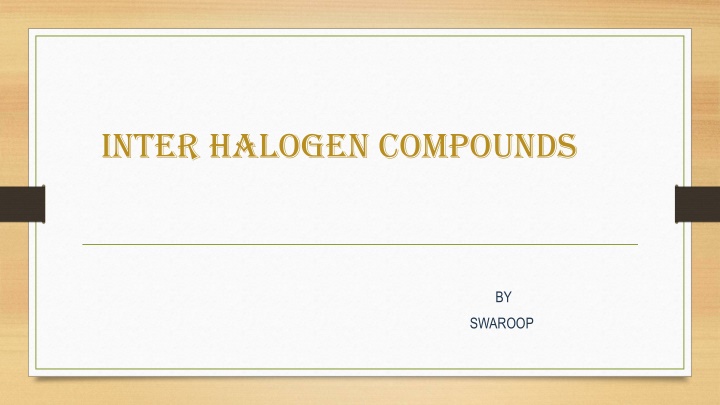
Interhalogen Compounds: Formation, Properties, and Uses
Interhalogen compounds are unique molecules formed when halogen group elements react with each other, displaying covalent and diamagnetic properties. Explore their preparation methods, physical properties, and various applications in industries such as catalysis and solvent use.
Download Presentation

Please find below an Image/Link to download the presentation.
The content on the website is provided AS IS for your information and personal use only. It may not be sold, licensed, or shared on other websites without obtaining consent from the author. If you encounter any issues during the download, it is possible that the publisher has removed the file from their server.
You are allowed to download the files provided on this website for personal or commercial use, subject to the condition that they are used lawfully. All files are the property of their respective owners.
The content on the website is provided AS IS for your information and personal use only. It may not be sold, licensed, or shared on other websites without obtaining consent from the author.
E N D
Presentation Transcript
INTER HALOGEN COMPOUNDS BY SWAROOP
INTRODUCTION Interhalogen compounds are compounds formed when halogen group elements react with each other In other words, it is a molecule which consists of two or more different elements of group 17. There are four types of interhalogen compounds: Diatomic interhalogens (AX) Tetratomic interhalogens (AX3) Hexatomic interhalogens ( AX5) Octatomic interhalogens (AX7) A halogen with large size and high electro positivity reacts with an element of group 17 with small size and lower electro positivity. As the ratio of the radius of larger and smaller halogen increases, the number of atoms in a molecule also increases.
Preparation of Interhalogen compounds These molecules are formed due to the direct combination or by the action of a group 17 elements with a lower interhalogen compound under specific conditions. For example: At 437K, chlorine reacts with fluorine of equal volume to form ClF. This method is widely used in the production of group 17 fluorides. Cl2+F2 2ClF (473K) I2+ Cl2 2ICl Properties of Interhalogen Compounds These molecules are covalent and diamagnetic in nature. The bonds formed between these compounds are more reactive than diatomic halogen bonds. The physical properties of these molecules are transitional between their constituents. The molecular structure of AX3molecules is bent T shaped, and AX5molecule is square or pyramidal and the structure of AX7is bipyramidal or pentagonal. The bond length depends upon the size of the constituent halogens. The molecule which consists of lighter group 17 elements is fairly colourless but one which is made up of higher halogens is deeper in colour which is due to the rise in the molecular weight.
Uses of Interhalogen Compounds These are used as non-aqueous solvents. They are used as a catalyst in a few reactions. UF6which is used in the enrichment of235U is produced by using ClF3and BrF3. U (s) + 3ClF3(l) UF6(g) + 3ClF (g) These are used as fluorinating compounds.
